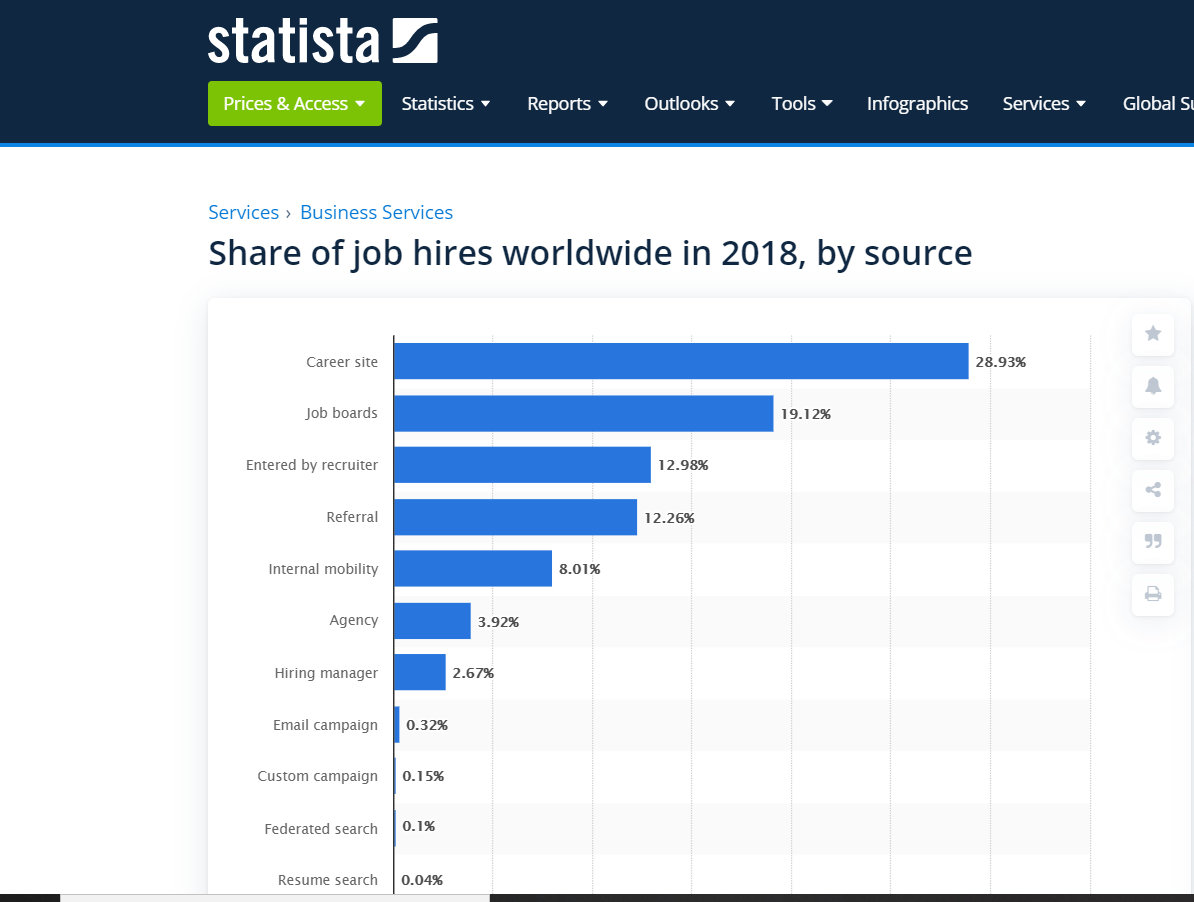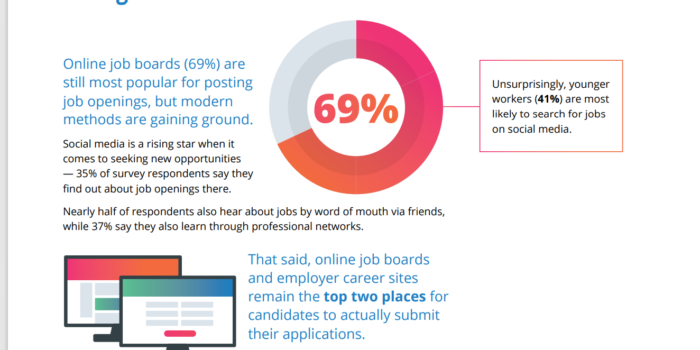I’ve seen some hot discussions between recruiters around terminology and data used in the career coaching sector. The one that makes temperatures rise is the phrase “the hidden job market.” As someone who sits on both sides of the table, I have sat back in reflection mode monitoring what has been going on. I’ve also done some research to try and find some information to match what each group is saying with my own experience.
Is it just a question of updating language and/or statistics or more than that? As I dug deeper, I found it was complex and more nuanced as things usually are. It’s not straight forward.
Hannah Morgan, Job Search Strategist suggests just getting data is difficult:
I think it’s almost impossible to track a single source of hire. That’s why it’s harder to find data. Jobvite is one of the few sources I’ve seen lately.
— Hannah Morgan (@careersherpa) June 10, 2021
She is not wrong.
The Hidden job market
The “hidden job market” has been used traditionally to describe jobs which were not publicly advertised, dating probably from the pre-internet 1980s. This has become the go-to, short-cut term which in a digital age could be potentially misleading and is no longer relevant.
What does happen in these discussions, is the people who get most confused are the job seekers. So maybe it’s time to turn down the heat around this piece of the candidate sourcing and job search process, and do some reframing.
Amy Miller, a senior Tech Recruiter who has been a campaigner against the term says:
I guess it depends on how we define “hidden” – hearing about a job from a friend doesn’t mean it’s not posted everywhere 🙂 I can honestly say 99.9% of the roles I’ve filled have been posted SOMEWHERE. No hiding happening here 🙂
— Amy Miller (@AlaRecruiter) June 10, 2021
Tejal Wagadi, Phoenix based Recruiter conducted a poll on LinkedIn in May 2021, to try and track where people posted their jobs. This is what she found: “500 people who voted that held recruiter, TA, HR titles. Over 52% of people voted that they post 90% + jobs online.”
How people get hired
As Morgan suggests, while estimates vary and it’s difficult to pinpoint exactly, research from Statista suggests that around 50% (see chart below) of job hires come from online ads on career sites and job boards. This is in line with Wagadi’s poll. This may also vary depending on geography, job level, function, size of an organisation and industry sector. Almost none of the jobs I recruit for are advertised for example.
There could also be some overlapping terminology. LinkedIn calls itself a professional network site, but it’s also one of the biggest job boards in town. 14 million jobs were posted on LinkedIn in October 2020 and 100 million job applications are made each month.
Neither Miller or Wagadi are incorrect. We are definitely basing a lot of our messages on information which needs updating.
Unknown job market
Because an organisation posts an advert online it doesn’t mean to say it is visible. Many jobs are indeed out there, but are very easy to miss and not visible to a particular job seeker and therefore unknown to that person.
What does this mean in real terms? Digital reach is so wide that a job could be posted anywhere.
- a range of job boards
- on company web sites
- blasted on social media (individual LinkedIn streams, Twitter, Instagram, Facebook etc.)
- disseminated into personal and professional networks
- sent to targeted networks (alumnae, location and professional groups)
- internal requests made for referrals from employees
- searches carried out by third parties for passive candidates.
- chance sightings – I frequently share openings I’ve seen with my network when I see individuals from organisations are posting vacancies directly into their LinkedIn streams.
Not everyone will see every single one of these opportunities, so they remain unknown.
How people HEAR about jobs
Research from Jobvite say that almost 50% of their participants hear about job openings from friends, while 37% say the hear about them through professional networks. (See chart below) So although jobseekers may apply for a job through a job board or a career site – they hear about it from other sources. In today’s candidate driven market with increased employee referral incentives offered we may see a spike here.
But are those jobs really invisible? Not really. Just with more limited publication.
Inaccessible job market
So although recruiters may receive job applications from career sites and job boards, in 50% of cases a network contact has given them the heads up. Lisa Rangel Executive Resumé Writer, makes a valid point that networking does not offer the same possibilities for some demographics. There are systemic reasons why this happens related to bias, culture and privilege.
I think it’s a matter of perspective. I have chatted with job seekers who are POC and I have been told they felt opportunities are more than unknown to them at times — they are hidden. Word usage can be a matter of perspective and experience.
— Lisa Rangel (@LisaRangel) June 11, 2021
This comment is supported by research from Payscale which suggests that “white men disproportionately win job referrals.” This effectively excludes other groups via embedded systemic unconscious bias.
They carry on to say: “Out of 100 referred employees, 44 will tend to be white men, 22 will be white women, 18 will be men of color and 16 will be women of color, the research authors pointed out. By comparison, according to the Bureau of Labor Statistics, white men represent only 34 percent of the U.S. labor market, which means white men are 129 percent more likely to be in a pool of 100 referred employees than what demographics suggest they should be.”
It can also about job openings that are only shared in a limited pool such as business schools or specific universities which have limited reach.
Rangel is not incorrect either.
So should we call it the “inaccessible job market?”
Role of networking
The role of networking everyone agrees is critical to gaining access to this information before they make a formal application. There are a number of different issues here because there is not a one-size-fits all solution:
Here’s why:
1. Cross cultural differences
In many cases there are layers of nuance and cultural differences associated with this. Much of this advice comes from the U.S. market which is much more individualistic than other geographies, so we have to factor in complex inter-cultural awareness issues. See the Hofstede country comparison with Germany for example. Job seekers in other geographies can get confused by advice coming from cultures where extraversion, drive, and “can do” attitudes, are key motivators which are recognised and rewarded.
2. Personality
As someone who has coached thousands of people, I can assure you that many would rather have root canal work without anaesthetic, or drink battery acid, than network. The idea of approaching a stranger fills them with dread. Can people pick up these skills from watching a few YouTube videos? Some can – but not everyone.
That’s why companies offer networking training and coaching to employees and those that don’t get it from their employer seek private coaching. It shouldn’t be under valued.
3. Gender
As I have written before, there is a gender network gap. There are fewer women than men on LinkedIn ( 43% women vs 57% men.) Women have higher levels of incomplete profiles and are 14%- 38% less likely to have a strong network depending on geography ) and 25% less likely to appear in searches.
An additional element is the high levels of harassment that women experience, even on LinkedIn which makes them more reticent to complete their LinkedIn profiles and network. (66% according to a poll carried out by Andy Foote, LinkedIn Strategist, in May 2020)
Time to be more specific
It’s clear it’s time to re-designate the term hidden job market and assign it a more appropriate term. The key question is what.
It’s clear that the majority of candidates APPLY for jobs via job boards and career sites to get hired. But also high numbers HEAR about these jobs from friends and their professional networks. But equally high numbers don’t have the same NETWORK ACCESS for systemic reasons or the skills to acquire access.
The real difficulty is finding something that covers all the nuances. I had favoured “unknown job market” in the past, but am now wavering towards “invisible job market.”
Here are the suggestions so far:
- Stay with hidden job market
- Invisible job market
- Unknown job market
- Inaccessible job market
- Networked job market
- Strategic job market
Or any other ideas?
If your organisations wants to DIVERSE top talent – get in touch NOW







